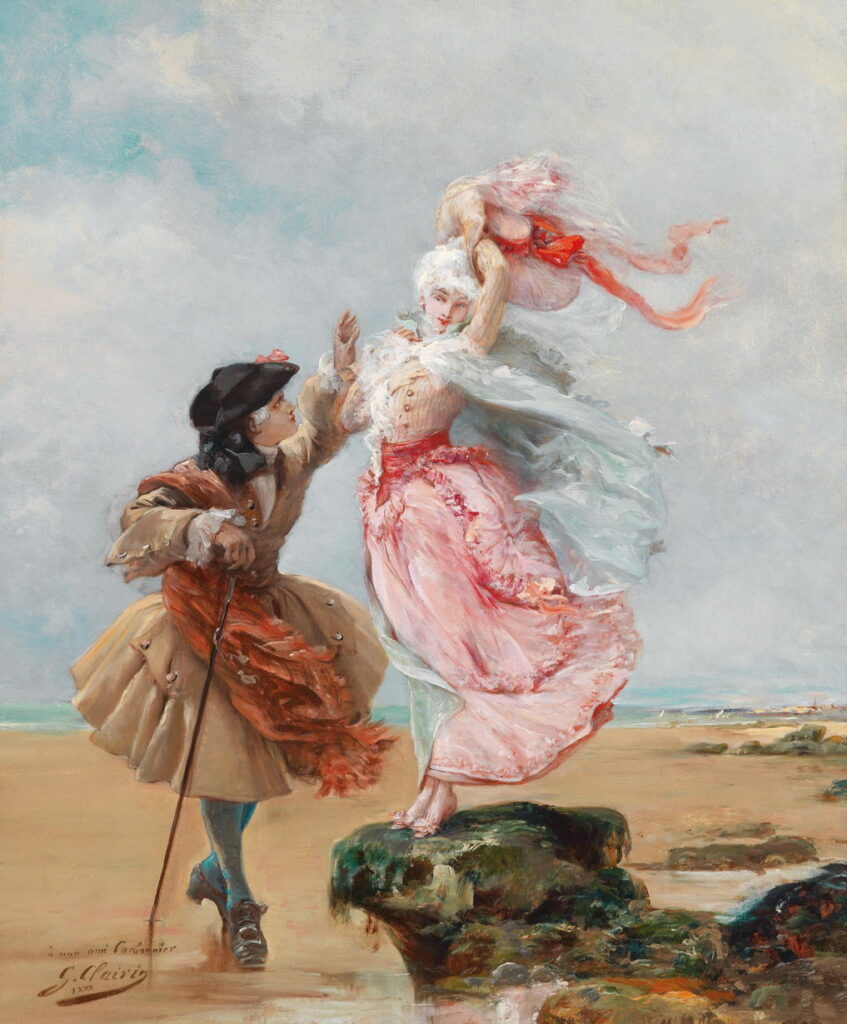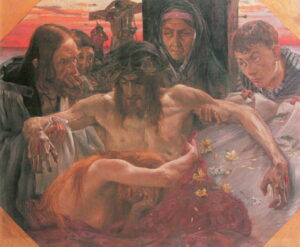Painting the blustery wind 2

In the first of these two articles looking at paintings of blustery weather, I showed examples up to 1875, concluding with Millet’s canonical Gust of Wind. Today we’ll see how the more fashionable coped with the wind in the city and on the coast, during the last decades of the nineteenth century.
Fashion is the antithesis of function. While countless generations of working people have looked to clothing for its warmth, protection and function, the select few have adorned themselves with garments that prevent them from doing anything useful. Once the wind picks up, though, their costly silks become excellent props for the painter.
Jean Béraud (1849–1935), A Windy Day on the Pont des Arts (1880-1), oil on canvas, 39.7 × 56.5 cm, The Metropolitan Museum of Art, New York, NY. Wikimedia Commons.
Jean Béraud, in his A Windy Day on the Pont des Arts (1880-1) above, and Milliner on the Pont des Arts (1879-82) below, uses clothing, particularly hats, and objects being carried to tell us how blustery it is. In the painting below, the man in the foreground is carrying a canvas and paint box, and could be a self-portrait, or perhaps the character Elixir from Proust’s popular Remembrance of Things Past, a composite of Whistler, Vuillard, Helleu, Béraud himself, and others.
Jean Béraud (1849–1935), Milliner on the Pont des Arts (1879-82), oil on panel, 37.5 × 56 cm, Private collection. Wikimedia Commons.
Winslow Homer (1836–1910), A Fresh Breeze (c 1881), transparent and opaque watercolor over graphite pencil on paper, 35.6 × 50.8 cm, Museum of Fine Arts, Boston, MA. Wikimedia Commons.
Once steamships were becoming more commonplace, their smoke became an obvious indication of the strength of the wind, as used by Winslow Homer in his watercolour A Fresh Breeze from about 1881. He painted this when he was working in the coastal village of Cullercoats in the north-east of England, a formative period in his career.
John Singer Sargent (1856-1925), A Gust of Wind (c 1886-7), oil on canvas, 61.6 x 38.1 cm, Private collection. WikiArt.
Unlike the woman in Claude Monet’s La Promenade from 1875, John Singer Sargent’s later virtuoso Gust of Wind (c 1886-7) is clearly being blown about, and holding onto her hat.
Paul César Helleu (1859–1927), Portrait of Mrs Helleu with an Umbrella (1899), oil on canvas, 81 × 65 cm, Private collection. Wikimedia Commons.
Alice, the wife of Sargent’s good friend Paul Helleu, features in Helleu’s windblown and loose oil sketch of Portrait of Mrs Helleu with an Umbrella (1899). Once seen, those billowing strips of fabric from the Renaissance are never forgotten.
Charles Courtney Curran (1861–1942), A Breezy Day (1887), oil on canvas, 30.3 x 50.8 cm, Pennsylvania Academy of the Fine Arts, Philadelphia, PA. Wikimedia Commons.
Loose and billowing washing is also useful in the depiction of wind; here Charles Courtney Curran makes it look A Breezy Day (1887) with their aid.
William McTaggart (1835–1910), A Westerly Gale, Machrahanish (1897), oil on canvas, 130.6 x 205.5 cm, Campbeltown Museum, Campbeltown, Scotland. The Athenaeum.
For serious wind, though, you should walk on the coast of Scotland, here with William McTaggart’s A Westerly Gale, Machrahanish from 1897, showing the rough conditions in this bay on the west coast of Kintyre.
Jules Victor Clairin (1843–1919), Elegant Couple at the Coast (date not known), oil on canvas, 65 x 54 cm, location not known. Wikimedia Commons.
Jules Victor Clairin’s undated Elegant Couple at the Coast comes not from the Rococo, but as indicated by the painterly style of the slippery rocks, was most probably painted in the early years of the twentieth century. Its very pink young ‘galante’ woman is a textbook example of how to make a figure look windswept, although her partner seems mysteriously to be unaffected by the breeze.
Lovis Corinth (1858–1925), Swimming in Horst – Ostsee (1902), oil on canvas, dimensions not known, Museum Georg Schäfer, Schweinfurt, Bavaria. Wikimedia Commons.
In Lovis Corinth’s view of Swimming in Horst – Ostsee (1902), the bracing waters of the Baltic are proving popular with these men in their new-fangled bathing trunks, and the smoke of a steamer in the distance demonstrates the brisk breeze.
Enjoy your walks in the blustery winds this autumn/fall.



